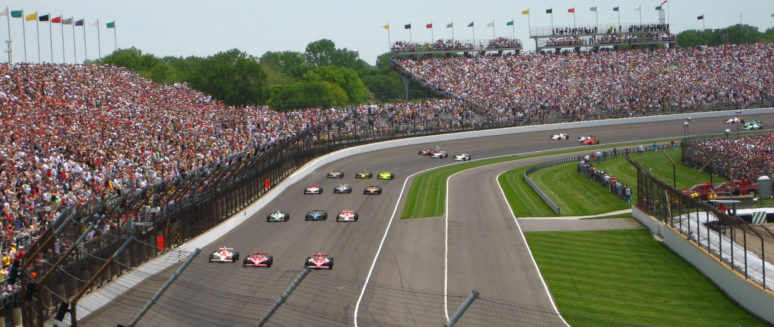The Indianapolis 500 mile race is the most recognized open wheel car event in the world. The only thing even arguably close is the Daytona 500.
With so much tradition surrounding this event and with all the legendary drivers, every young motorsports enthusiast that has ever dreamed of blazing around a track has pictured themselves doing it on the Indy 500 track.
The name of this track is none other than the famous Indianapolis Motor Speedway. Unlike many other tracks which have handed their names over to sponsors, Indy has not, and hopefully never will.
Indianapolis Motor Speedway “Brickyard” Basic Track Information
Opened: August 12, 1909
Cost to Build: $3 million
Architects: Carl Fisher, James Allison, F.H. Wheeler and Arthur Newby
Type: Rectangular Oval
Length: 2.5 miles (4.023 km)
Surface: Asphalt & Brick
Number of Turns: 4
Banking: Turns (9.2 degrees) Straights (0 degrees)
Current Capacity: 400,000 (235,000 permanent seats)
Indy 500 Race Track: Interesting Facts & Records
Have You Heard of Speedway, Indiana?
Here is a little-known tidbit that even many enthusiasts don’t know. The Indy 500 takes place in the town of Speedway, Indiana, which is entirely surrounded by Indianapolis, Indiana. The town consists of the track and that’s about it.
It’s Been Around A Long Time
Indy Motor Speedway was built back in 1909, making it the second oldest racetrack in the country (only one in Milwaukee is older), and it is a monster. With 257,000 permanent seats and 150,000 more infield spots, more spectators can watch the Indy 500 live than any other sporting event.
Design
It is oval in shape with corners that aren’t nearly as banked as some of the other American race tracks. Still, the corners are steeper than what you see overseas. The long straightaways are 5/8 of a mile long and the short straightaways are 1/8 of a mile. The original designers can pat themselves on the back because the shape has changed very little over the years.
Records Are Meant to be Broken
For years it was Arie Luyendyk who held the record for the fastest Indianapolis 500, but that record was put to rest in 2013. Tony Kanaan won with an average speed of 187.433, crushing Luyendyk’s previous record of 185.981 mph. That wasn’t the only record that was broken in 2013. The race featured 68 lead changes and 14 different leaders, both new records. It doesn’t stop there. The 26 cars to finish were the most ever as were the 5,863 laps completed in the field. 2013 also saw a record low in caution laps (21) and the longest stretch of caution free racing (133-laps).
National Landmark
The Indy Motor Speedway has been recognized as a piece of history by more than just racing fans. In 1975, it was placed on the National Register of Historical Places and was given the designation of a National Historic Landmark in 1987. That makes it the only facility in the United States related to auto racing to garner that honor.
Why They Call it the Brickyard
Many fans simply know this track by its nickname – the Brickyard. This name comes from a look back at the very first race at the storied track which was run on crushed stone and tar. As you might expect, if you have ever gone at high speeds on gravel roads, it was an accident waiting to happen. In an effort to make the surface safer, Carl Fisher, came up with the solution of covering it with 3.2 million bricks. Three feet of these original bricks still remain at the finish line.

